Aruba’s turquoise waters, dazzling, white tropical beaches, fascinating desert-like topography, and colorful architecture beckon you to visit.
However, touring this heavenly Caribbean island of Aruba brings you closer to an assortment of untamed nature and vicious wildlife.
Over 150 animal species view Aruba’s 180 km² total area as home. Some of the most dangerous animals in Aruba include snakes, spiders, and sharks. As such, you must look out for these deadly animals as you explore the Caribbean island’s picturesque terrains.
This is why we have gone ahead to compile a list of the deadliest animals in Aruba you must know about, and some wildlife safety tips at the end of the list.
What are the Most Dangerous Animals in Aruba?
1. Aruba Island Rattlesnake
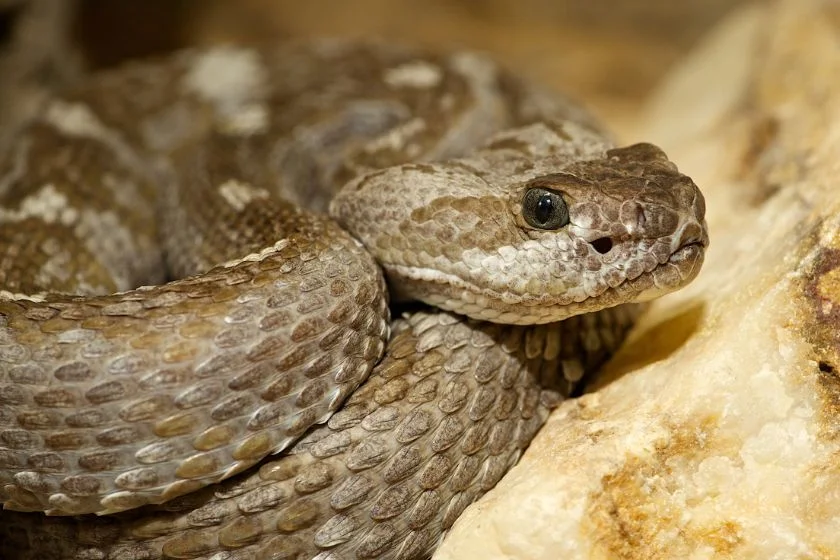
- Scientific Name: Crotalus unicolor
- Classification: Reptiles
- Habitat: Undisturbed rocky, sandy, and arid hillsides
- Diet: Carnivore
- Conservation Status: Critically Endangered
There are thirty-six known rattlesnake species, and the Aruba Island rattlesnake is endemic to Aruba.
It is a critically endangered specie, and we are glad to find one of its most significant breeding populations in the Caribbean country.
However, the Aruba rattlesnake is a highly venomous pit viper with hemotoxins and neurotoxin that breaks down their prey’s tissue.
They often strike humans with dry bites in defense but can eject large volumes of venom.
Victims should seek emergency medical care to avoid complications from Aruba island rattlesnake bites.
2. Baker’s Cat-Eyed Snake
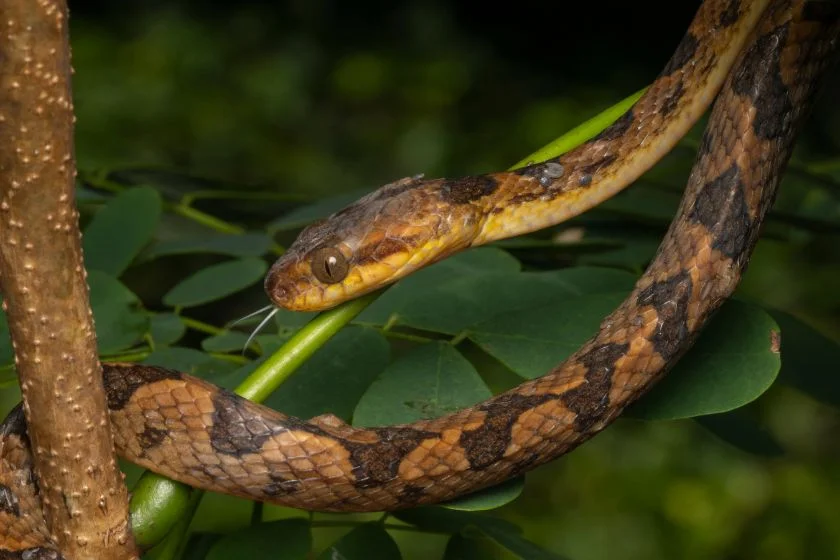
- Scientific Name: Leptodeira bakeri
- Classification: Reptiles
- Habitat: Grasslands, rainforests
- Diet: Carnivore
- Conservation Status: Not Evaluated
Arubians call the baker’s cat-eyed snake “santanero.” It is not the kind of snake you might love to raise as a pet because it stinks and leaves an unpleasant smell in your hand when you handle it.
You may find the santanero near dams during the rainy season; they hide among plant leaves or under rocks during the day, and you may find them on the road at night.
While baker’s cat-eyed snakes are not aggressive, they will strike when startled or threatened.
However, their venom is not fatal to healthy humans but potent enough to cause pain and bone aches, especially in the arms and legs.
3. Common Boa Constrictor
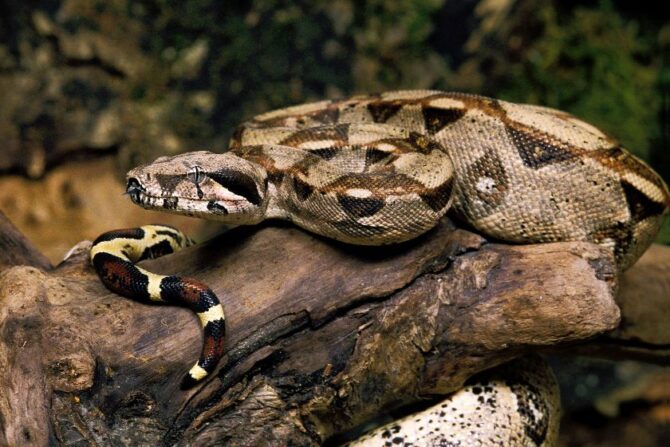
- Scientific Name: Boa constrictor
- Classification: Reptiles
- Habitat: Tropical rainforests, arid semidesert
- Diet: Carnivore
- Conservation Status: Not extinct
Aruba is arid but under its bushes and trees are humid enough to support the boa’s multiplying increase.
Expect to find boas in the park and throughout the country. You may find boas in hotel gardens and local backyards, such that about two hundred were captured in one year.
The boa constrictor is considered an invasive species in Aruba; records show that these giant snakes consumed 52,000 mammals, birds, and reptiles in Aruba in 2011.
The boa constrictor is not generally aggressive towards humans as they are too big to prey on. Nevertheless, a boa would not hesitate to strike in defense if it identifies a threatening action.
Their brute strength and ability to suffocate their prey also make them dangerous. Therefore, the giant reptile is worthy of featuring on our list.
4. Jellyfish
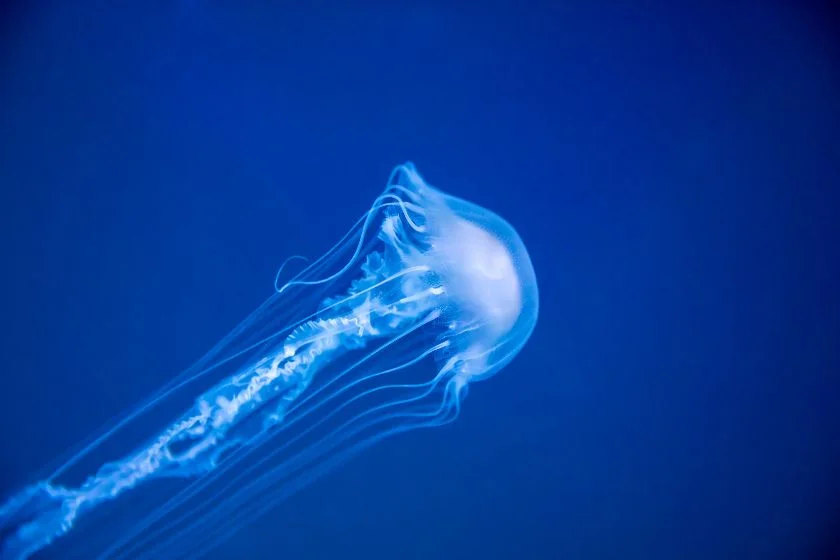
- Scientific Name: Aurelia
- Classification: Scyphozoa
- Habitat: Warm, shallow, marine waters of the subtropics and tropics
- Diet: Carnivore
- Conservation Status: Not Evaluated
If you feel something strange like itching or see your skin turning red, the situation is nothing out of the ordinary. Aruba waters are known for their jellyfish abundance.
The wind’s constant directional changes result in the ocean currents’ directional changes during the rainy season, bringing unusual animals like the jellyfish into Aruba’s surrounding waters.
Unfortunately, jellyfishes are transparent, making it difficult to see and avoid them, and they do not hesitate to touch humans and sting multiple poisoned microneedles into their skin.
Jellyfish stings are usually painful, characterized by red marks, pain, itching, numbness, or tingling.
However, some species like the box jellyfish (sea wasp) have deadly stings that may lead to cardiac arrests within minutes.
It may be difficult to tell which jellyfish species stung you in the water, so immediately leave the water to avoid more encounters and seek medical help if you feel systemic reactions.
5. Sharks
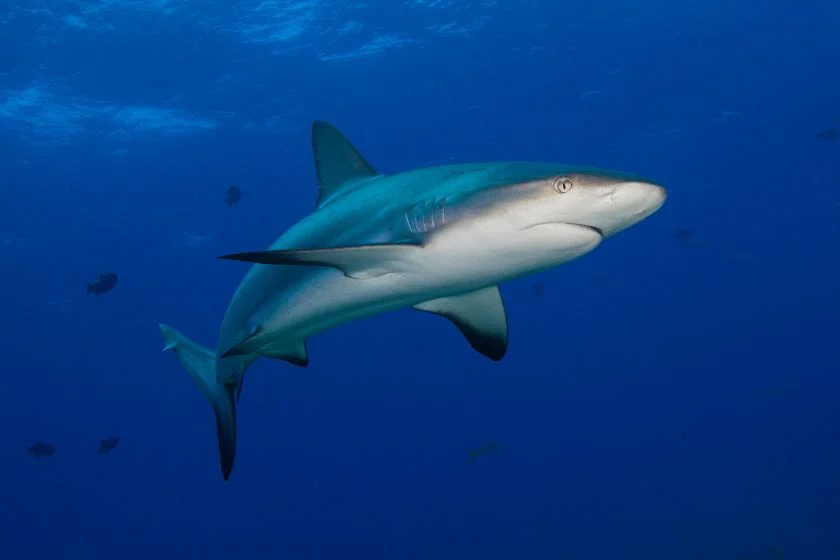
- Scientific Name: Selachimorpha
- Classification: Chondrichthyes
- Habitat: Shallow to deep seas in coasts, marines, and oceans
- Diet: Carnivore
- Conservation Status: Endangered
Even a vast array of marine life enjoy Aruba’s warm, crystal clear waters. Therefore, expect to find sharks as you enjoy the calm waters of the Caribbean country’s award-winning beaches.
Hammerhead sharks, Caribbean reef sharks, and whale sharks are the commonest shark species in Aruba. They are usually out in deeper waters, occupying the Caribbean ocean around the country.
Still, visiting snorkelers, boaters, and scuba divers might unexpectedly encounter a shark.
Movies portray sharks as rouge hunters, but experts believe sharks are gentle giants that deserve our respect. Fortunately, Aruba’s commonest shark species are non-aggressive towards humans.
It would be best to be cautious as these sea giants may translate some human activities as provocative and threatening, resulting in a violent reaction or attack.
Sharks have very sharp teeth and rip off chunks of flesh, severely wounding or killing a victim.
On a brighter note, no fatalities have ensued from the twenty-four recorded reef shark attacks.
6. Green Iguana
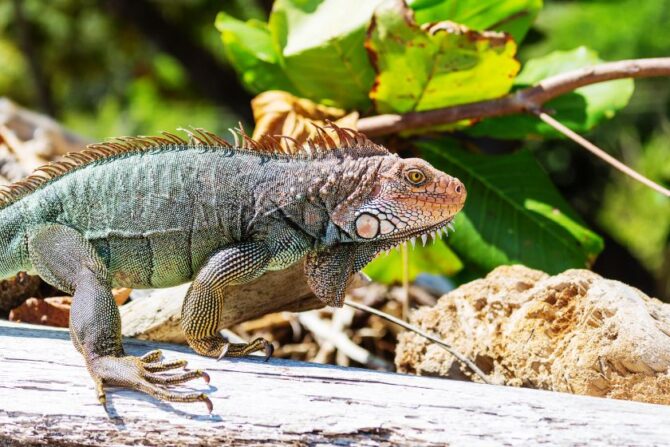
- Scientific Name: Iguana iguana
- Classification: Reptiles
- Habitat: Rainforests
- Diet: Herbivores
- Conservation Status: Not Evaluated
While green iguanas are colorful and undoubtedly beautiful, they do not look like the kind of reptiles you would want to go close to if you are strange to wildlife.
You might even feel more reluctant to fall in love with them knowing they are venomous, have sharp tails and strong jaws with razor-sharp teeth, average 6.5 feet long, and weigh about eleven pounds as adults.
However, green iguanas are among the most popular reptile pets; many even die within a year of domestication because of the challenges associated with receiving proper and adequate care.
These wild lizards are relaxed and friendly animals that rarely attack humans without reason.
Their venom is weak and relatively harmless to humans, but they can cause considerable damage if forced to attack.
Green iguanas can skillfully use their sharp tails to defend themselves, while their powerful jaws with sharp, serrated teeth can severely injure a human during an attack.
Aruba Wildlife Safety Tips
Knowing which dangerous species to avoid in Aruba is not enough, but a few wildlife safety tips will do.
Please apply the following guidelines dealing with wildlife on the island.
Wear a protective suit
Please remember that jellyfishes are transparent, making them difficult to see and avoid.
Therefore, it will be best to wear a protective suit while enjoying Aruba’s warm and clear waters because of jellyfishes.
You can get a skin suit or stinger suits made of thin, high-tech fabric and a pair of protective footwear as jellyfishes also sting humans wading in shallow waters.
Do not interact with wildlife
It is wise never to follow or approach wild animals due to their unpredictability and defensive instincts.
Animals may interpret close or sudden movements as threats and react aggressively to protect themselves.
Only swim in designated areas
Sharks occupy the Caribbean ocean around Aruba, so it is wise to only swim in designated areas.
The shark species in Aruba are less aggressive towards humans, but you had better be safe than sorry.
Sports like snorkeling, boating, and scuba diving may take you farther into the sea, but be cautious while having the best time of your life.
Wrap Up
Appreciate and admire nature, but not at the expense of your safety.
While you sit on Aruba’s sparkling white sands, swim in its waters, or enjoy seeing its wildlife, have it in the back of your mind that dangerous species lurk around.
We have helped you with the list of the most dangerous animals in Aruba to look out for and outlined some safety tips to keep you safe.
Related:
10 Most Dangerous Animals In Fiji That Are Deadly






